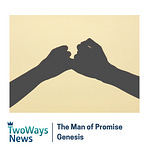That revision of the Two ways to live outline that I’ve mentioned once or twice?
Well it’s nearly done. The final commas are being debated. Some new designs are being workshopped. I’ve even seen mock-ups of some very fetching t-shirts and caps (remember when we used to call that ‘witness wear’?).
The feedback we’ve received about the proposed changes has been really useful and encouraging, and some good questions have been asked.
One recent excellent question concerned the value of learning a single gospel outline like Two ways to live when the gospel can be expressed in a range of different forms. If there is ‘one gospel but many forms of it’ (as is often said these days), why learn just one outline? Won’t this restrict our ability to adapt the gospel into the many different forms that we may need in different contexts and cultures?
My immediate response to this question is to say: “Well that is, in fact, precisely what Two ways to live is designed for”.
The whole point of Two ways to live is to equip Christians for a multitude of different conversations about the one biblical gospel. You learn the essential elements of the gospel thoroughly in a skeletal, bullet-point framework, along with some imagery to help remember it. And once you’ve done that, you’re equipped to talk about that message in a multitude of different ways in different contexts with different people: in casual conversations over coffee, around the dinner table with your kids, in a more formal presentation (a children’s talk, a youth talk, a sermon), in a seven-week evangelistic course, in a letter to a friend, to a completely unchurched millennial, to a lapsed Catholic, to a Buddhist, and so on.
In all these different contexts and modes of communication, the presentation of the elements of the gospel framework will come out differently. As you sit on a bench with a friend at a mountain lookout and marvel at the beauty in front of you, the conversation might start at Box 1 (creation). Or if you’re talking about what’s wrong with our lives and our world, the discussion might begin and linger in Box 2 for a while (our rebellion against God and the consequences). Every Two ways to live gospel conversation or explanation will be different, depending on who you are as the speaker (i.e. how you speak), and depending on where the person (or people) you’re talking to are at—their existing knowledge of the Bible, the particular questions they are raising, and so on.
But the message you communicate (if you’re faithful to it) will be the same, because the one biblical gospel is a message for everyone.
This came home to me afresh just this last weekend in a sermon I preached about Peter’s gospel proclamation to Cornelius in Acts 10. There’s a lot of dramatic hoo-haa in Acts 10 to actually get Peter into the room with the gentile Cornelius and his gentile friends, so that he can preach to them. Up to this point, it seems not to have completely dawned on Peter yet that the gospel is indeed a message for everyone—even the despised and unclean gentiles.
But when he finally does get it, and opens his mouth and speaks to Cornelius and co, he reveals why the message he’s been commanded to preach is a message for every single person in the world, regardless of their culture, aspirations, or existing beliefs.
His message is the proclamation and announcement of certain historical events—the good works and healing ministry of Jesus of Nazareth, his death on a tree, and his resurrection from the dead—and the meaning and implications of those events for every person in the world. Peter sums up those implications like this:
And he commanded us to preach to the people and to testify that he is the one appointed by God to be judge of the living and the dead. To him all the prophets bear witness that everyone who believes in him receives forgiveness of sins through his name.
This is basically what he also preached (with some extra OT background) to the assembled Jewish crowd at Pentecost—that the crucified and risen Jesus is Lord and Christ (i.e. the king and judge of the world), before whom they should repent for the forgiveness of their sins (Acts 2:36-38). Interestingly, Peter also at Pentecost says that this promise is ‘for you and your children and for all who are far off, everyone whom the Lord our God calls to himself’ (Acts 2:39). Perhaps he didn’t realise at that point just how far the ‘far off’ would take him, and that ‘everyone’ really meant everyone.
But by Acts 10 he has figured it out (thanks to the Lord’s patient instruction). He realises that his gospel is a single, universal message for every person from every nation and culture, because the crucified and risen Jesus is the Lord and Judge of every person, living or dead, and offers forgiveness of sins to ‘everyone who believes in him’.
It also strikes me how similar this is to the conclusion that Paul comes to in his sermon in Acts 17. My quick paraphrase of Paul’s sermon to the Athenians:
You guys have come up with all kinds of different ways to make sense of your lives and to try worship something. But it’s all nonsensical, and the time for that kind of ignorance is over, because God has now appointed the risen Jesus to be the righteous judge of all the world. So it’s time for everyone, from every culture, no matter what worthless idol you might currently worship, to repent.
Or words to that effect.
It’s the same as the Great Commission in a way. All authority (to rule and to judge) has been given to the risen Lord Jesus—go, therefore, and make disciples of all nations.
The reason that the one message is the same for everyone is that it is about the universal Lord and Judge, Jesus Christ.
To come back to the question that was posed about Two ways to live—I suspect that when people today talk about ‘one gospel in many forms’, they don’t just mean the many different forms of conversation and communication that I talked about above. They mean that the gospel needs to be expressed in different conceptual forms in order to connect with different cultures. For example, in a culture that values ‘freedom’ (but is struggling to achieve it) we might cast the gospel in a form that answers or resonates with that cultural narrative—as a message about the true freedom that is found in Jesus. And so on.
But this is not how the apostles bridged cultures with the message of Jesus—and the whole point of Acts 10 is that the cultural chasm between Peter and his hearers was vast. The point of connection was not how that particular culture’s aspirations might be fulfilled by the gospel. The point of universal relevance was that the risen Jesus Christ was their Lord and Judge as well, the one before whom they must repent, and the one who would grant them forgiveness of sins by his atoning death.
In my reading of it, the ‘one gospel, many forms’ approach of recent times sees the gospel as a more malleable message, to be contextualized or framed around the particular cultural aspirations of our hearers. I wonder if the reason for this is that Box 5 of Two ways to live—that the risen Jesus is Lord and Judge of all—has receded somewhat into the background. The focus is more on how Jesus saves, liberates, restores and fulfils—that is, on how he meets the particular need that we have (including the need for forgiveness of sins). And so the way to make that message universal is to frame it differently for each different person or culture, depending on how that person or culture perceives or expresses their basic need.
There are a number of problems with this approach, but the chief one for me is simply that it’s not at all how the apostles did it. And if we are to be good apprentices of theirs, this should chasten us. In the apostolic gospel preaching, the point of ‘contact’ was not the particular form of my culturally-conditioned need—it was the fact that Jesus Christ has been appointed Lord and Christ and Judge of every single person, nation and culture for all time, by virtue of his resurrection from the dead; that all should repent before him; and—wonderfully—that all may receive forgiveness of sin in his name.
Two ways to live is an attempt to distil that message into a simple, memorable outline. It’s not the only way it could have been done (and no doubt will be done). But the message that it seeks to summarize is the one that, like Peter, we’ve been commanded to preach.
PS
Sorry that this week’s edition is a bit late. It’s a big topic, and I found it hard to boil down into something of respectable length. One cheeky sentence that ended up on the cutting room floor was this one:
When someone suggests that we need to keep adapting the form of the gospel message so that it connects with the cultural narratives of our hearers, I’m tempted to say: ‘Well that’s exactly what I’d expect someone from a Western, post-modern, humanist culture to say’.
What do you think: painful but fair?
If you’ve been finding The Payneful Truth enjoyable or stimulating or helpful, or even all of those things, then why not spread the joy? Think of four or five friends that might also benefit, and forward this email to them with an encouragement to sign up on the free list.
And if you’d like to receive every edition, every week—and not just these free ones every three weeks or so—you can sign up to become a ‘Payneful Partner’ here …











